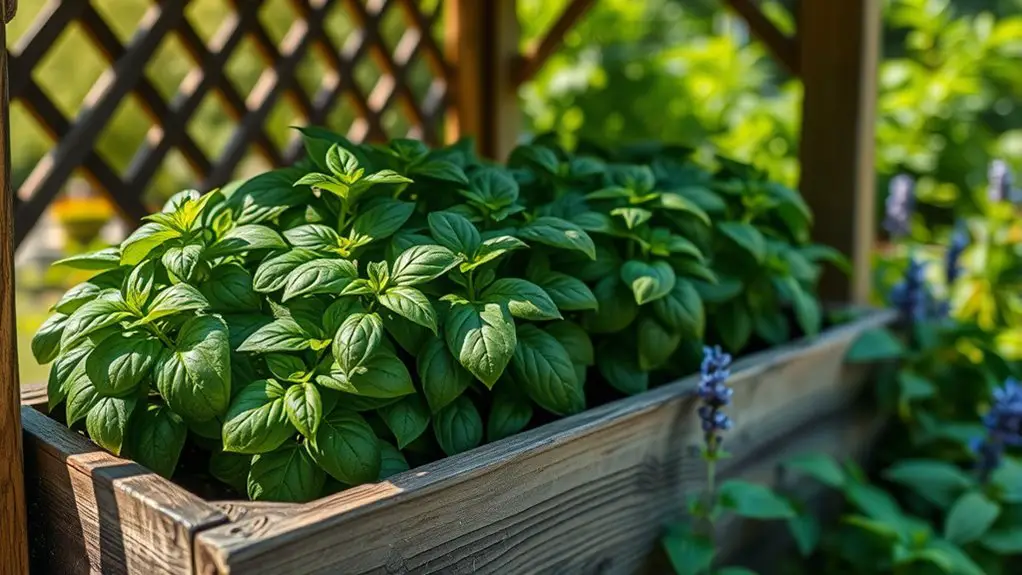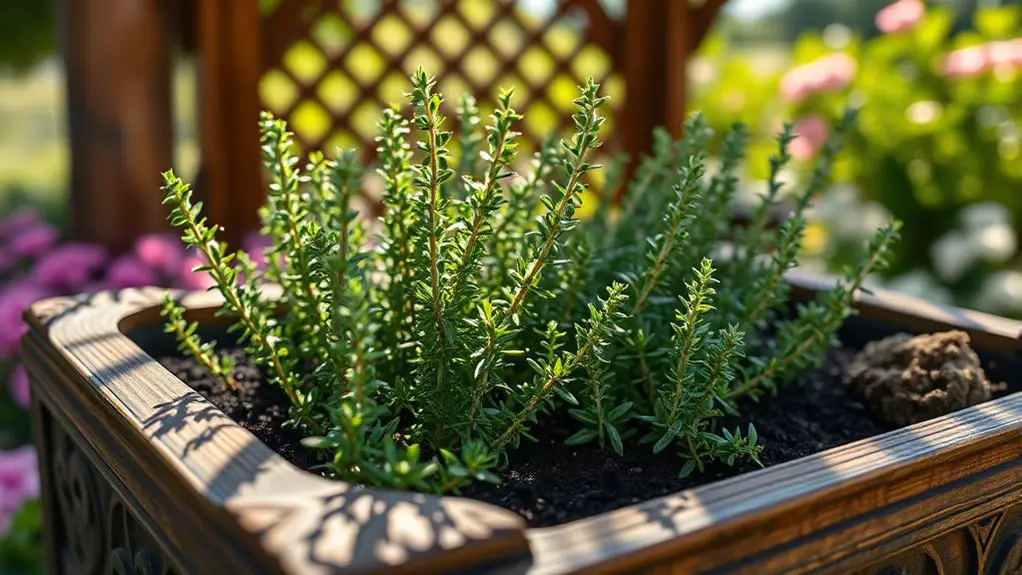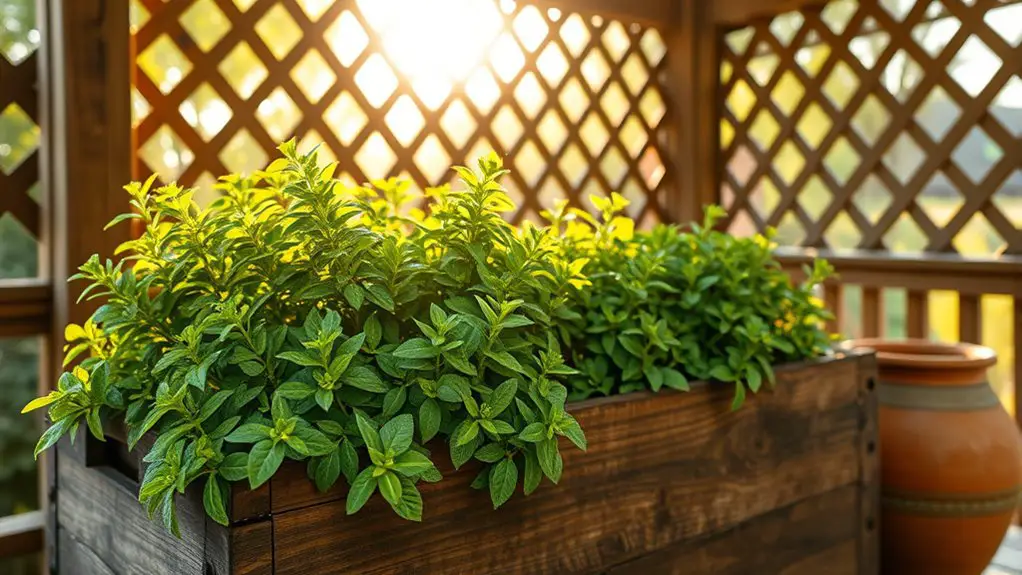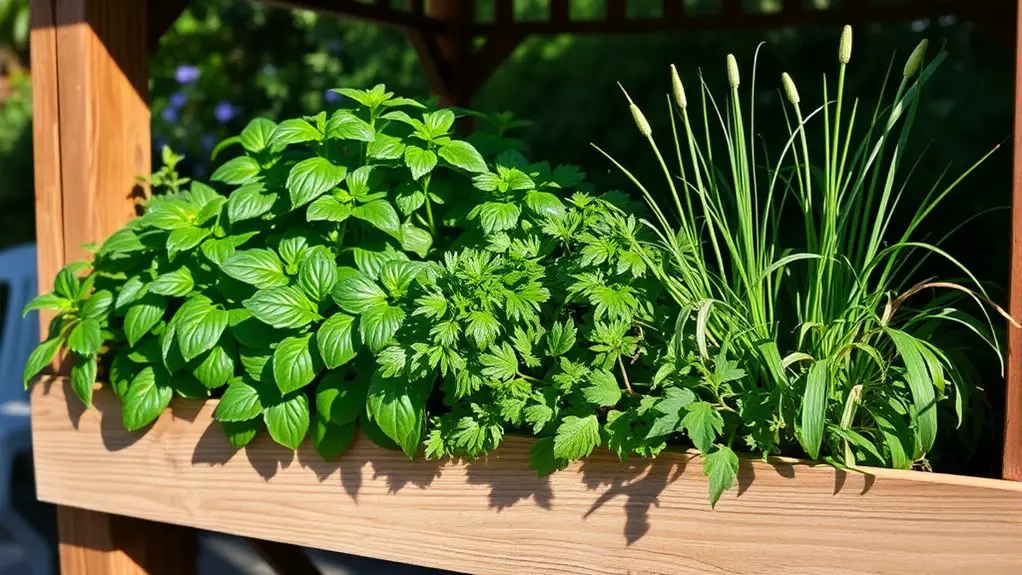For a gazebo planter box, consider growing basil, mint, thyme, oregano, chives, and cilantro. These herbs thrive in well-draining soil and enjoy ample sunlight. Basil and mint add versatile flavors, while thyme and oregano are essential for delicious Italian dishes. Chives offer a mild onion taste, and cilantro enhances salsas and tacos. These herbs not only elevate your meals but also provide a delightful gardening experience, so let’s explore how to care for them to maximize your herb garden’s potential.
Basil: A Versatile Favorite

Basil, often hailed as the king of herbs, is a staple in many gardens and kitchens alike. This versatile herb boasts numerous basil varieties, each with unique flavors and aromas, like sweet basil, Thai basil, and purple basil. Choosing the right variety depends on your culinary preferences and the dishes you enjoy.
When it comes to basil care, it’s essential to provide well-draining soil and plenty of sunlight, ideally six to eight hours a day. Regular watering is key, but avoid overwatering to prevent root rot. Pinching off the tops encourages bushier growth and prevents flowering, which can alter the flavor profile.
Growing basil in a gazebo planter box allows you to enjoy its fragrant presence while easily accessing it for cooking. With just a bit of attention and care, you can cultivate a thriving basil plant that enhances your garden and culinary creations alike.
Mint: A Refreshing Addition
After exploring the delightful world of basil, it’s time to contemplate another herb that can elevate your culinary experience: mint. This versatile herb boasts numerous mint varieties, each with its unique flavor profile. From spearmint’s sweet notes to the robust taste of peppermint, there’s a type for every palate. Growing mint in a gazebo planter box allows you to have fresh leaves at your fingertips, perfect for cocktails, salads, or even desserts.
One of the best aspects of mint is its ease of preservation. You can dry or freeze the leaves, ensuring you have this invigorating herb on hand year-round. Just remember to keep mint in check, as it can be quite invasive in garden spaces. With proper care and attention, you’ll have a thriving mint plant that adds a burst of flavor to your dishes and drinks, enhancing your culinary adventures while enjoying the freedom of home gardening.
Thyme: A Flavorful Herb

Thyme thrives in well-drained soil and plenty of sunlight, making it an excellent choice for your gazebo planter box. This versatile herb not only enhances a variety of dishes but also offers a rich aroma that elevates your culinary creations. Understanding the proper techniques for harvesting and storing thyme will guarantee you enjoy its flavor long after you’ve picked it.
Growing Conditions for Thyme
When it comes to cultivating thyme, understanding its growing conditions is vital for achieving healthy, flavorful plants. Thyme thrives in well-draining soil with a pH level between 6.0 and 8.0; sandy or loamy mixes work best. When planting, make certain your planter box has adequate drainage to prevent root rot. For watering techniques, thyme prefers a “less is more” approach—allow the soil to dry out between waterings to mimic its natural habitat. Overwatering can lead to issues, so check the top inch of soil before adding more moisture. By creating the right conditions, you’ll not only nurture robust thyme plants but also enjoy the satisfaction of growing this delightful herb in your gazebo planter box.
Culinary Uses of Thyme
One of the most versatile herbs in the culinary world, thyme adds depth and complexity to a wide array of dishes. It pairs beautifully with meats, vegetables, and even in sauces, enhancing flavors without overpowering them. Beyond its culinary uses, thyme also boasts medicinal properties, like aiding digestion and acting as an antiseptic.
| Culinary Pairings | Dish Ideas |
|---|---|
| Chicken | Roasted thyme chicken |
| Vegetables | Thyme-infused ratatouille |
| Soups | Thyme in vegetable soup |
| Sauces | Creamy thyme sauce |
Incorporating thyme into your cooking not only elevates your meals but also brings a touch of health benefits, making it a must-have in your gazebo planter box.
Harvesting and Storing Thyme
After enjoying the culinary delights thyme brings to your dishes, understanding how to properly harvest and store this herb is crucial for maximizing its flavor and longevity.
- Use sharp scissors or pruning shears for clean cuts.
- Harvest in the morning for best flavor.
- Store thyme in a cool, dark place to maintain its potency.
- Consider drying or freezing for long-term thyme storage.
Employing effective harvesting techniques, like cutting stems just above the leaf nodes, encourages new growth. For thyme storage, wrap fresh sprigs in a damp paper towel and place them in a plastic bag in the fridge. Alternatively, dry the leaves on a screen or hang them upside down. This guarantees you always have flavorful thyme on hand for your culinary adventures.
Oregano: Perfect for Italian Dishes

Oregano is an essential herb in Italian cuisine, known for its robust flavor that enhances dishes like pizza and pasta. To successfully grow oregano, you’ll need to take into account its specific growing conditions, including full sun and well-drained soil. Understanding its culinary uses and care requirements can help you cultivate this aromatic herb right in your gazebo planter box.
Culinary Uses of Oregano
When it comes to Italian cuisine, few herbs are as indispensable as oregano. This aromatic herb not only enhances flavor but also provides numerous oregano health benefits. You’ll find it essential in various dishes, from sauces to marinades. Here are some culinary uses to contemplate:
- Pasta sauces: Elevate your marinara or pesto with fresh oregano.
- Pizza toppings: A sprinkle of oregano adds depth to your favorite pizza.
- Meat dishes: Use it in marinades or rubs for chicken or beef.
- Salads: Incorporate it into dressings for a zesty kick.
To enjoy oregano year-round, explore oregano preservation methods like drying or freezing, ensuring you always have this versatile herb at hand. Embrace its flavor and health benefits in your cooking!
Growing Conditions Required
To successfully grow oregano, you’ll need to create the right conditions that mimic its native Mediterranean habitat. This herb thrives in areas with ideal sunlight, so place your planter box where it can soak up at least 6-8 hours of direct sunlight daily. Oregano prefers well-draining soil that’s slightly dry; too much soil moisture can lead to root rot. Ideally, aim for a pH level between 6.0 and 8.0 to guarantee healthy growth. Water your oregano sparingly, allowing the top inch of soil to dry out between watering sessions. With these conditions, your oregano will flourish, providing you with fresh, aromatic leaves for your Italian dishes while enhancing the freedom of your culinary creativity.
Chives: A Mild Onion Flavor
Chives are a versatile herb that brings a subtle onion flavor to your culinary creations. If you’re looking to enhance your dishes without overwhelming them, chives are your go-to herb. Their delicate taste pairs well with various ingredients, making them perfect for numerous chives recipes.
Consider these key points about chives cultivation:
- Easy to Grow: Chives thrive in various conditions, making them suitable for your gazebo planter box.
- Rapid Growth: You’ll see results quickly, allowing for frequent harvesting.
- Nutritional Boost: They’re rich in vitamins A and C, adding health benefits to your meals.
- Long Harvesting Season: Enjoy fresh chives from spring through fall, ensuring a continuous supply.
Incorporating chives into your cooking can elevate your dishes while also bringing satisfaction to your gardening experience. Embrace the freedom of growing and using this delightful herb!
Cilantro: Essential for Salsas and More
Cilantro, often considered a staple in various cuisines, is indispensable for crafting vibrant salsas and fresh salads. This herb’s bright, citrusy flavor elevates dishes, making it a favorite in Mexican, Asian, and Middle Eastern recipes. Beyond its culinary allure, cilantro boasts numerous health benefits. It’s rich in antioxidants and vitamins A and K, promoting overall wellness and aiding digestion.
When you grow cilantro in your gazebo planter box, you’ll enjoy easy access to this versatile herb for your favorite cilantro recipes. Try it in guacamole, sprinkle it over tacos, or blend it into a rejuvenating chimichurri sauce. Plus, it’s simple to grow; just guarantee it gets plenty of sunlight and regular watering. With cilantro at your fingertips, you’ll enhance your meals while reaping its nutritional rewards. Embrace the freedom of homegrown ingredients, and let cilantro inspire your culinary creativity!
Frequently Asked Questions
How Much Sunlight Do Herbs Need in a Gazebo Planter Box?
You might think herbs need minimal sunlight, but they actually thrive with at least six hours daily. Understanding their sunlight requirements is essential for ideal herb growth, ensuring your plants flourish in a gazebo planter box.
Can I Grow Herbs Indoors in a Gazebo Planter Box?
Yes, you can grow herbs indoors in a gazebo planter box. For successful indoor gardening, focus on herb selection that thrives in lower light, like basil or mint, ensuring adequate drainage and moisture for healthy growth.
What Type of Soil Is Best for Herb Planter Boxes?
You’ve gotta consider soil drainage when choosing the best mix for your herb planter boxes. A blend of quality potting soil and organic fertilizers boosts growth, ensuring your herbs thrive in a well-balanced environment.
How Often Should I Water Herbs in a Gazebo Planter Box?
You should water your herbs based on their moisture needs and the season. Generally, check the soil’s moisture every few days; if it’s dry an inch down, it’s time to water. Adjust accordingly for weather.
Are There Any Companion Planting Tips for Herbs in a Planter Box?
Companion planting’s like creating a harmonious symphony in your garden! For successful herb pairings, consider planting basil with tomatoes and cilantro with peppers. These strategies enhance growth, flavor, and pest resistance, making your planter box thrive.

